Object as a stand in for the body
- Marina WitteMann
- Apr 27, 2021
- 5 min read
Updated: Dec 13, 2021
Through clothing, the artist can consider various aspects of society's cultural, religious, ethnic, political and much other life.
For example, “British-born, Nigerian artist Yinka Shonibare MBE (born in 1962) works across diverse artistic media to explore ideas about African contemporary identity and the legacy of European colonialism in the present. Shonibare’s art considers social class and aesthetics and is characterised by the use of recurring visual symbols such as ‘Dutch wax’ fabric, since the mid 1990s.” (Museum of Contemporary Art Australia, Yinka Shonibare MBE 2008 At: https://www.mca.com.au/artists-works/exhibitions/yinka-shonibare-mbe/ (Accessed 27.04.2021))

Yinka Shonibare, How to Blow up Two Heads at Once (Ladies), 2006. Davis Museum and Cultural Centre, Wellesley College, Wellesly, MA, USA, Museum purchase, Wellesley College Friends of Art. Installation view, Yinka Shonibare MBE, MCA, 2008. Image courtesy of the artist, Stephen Friedman Gallery, London and James Cohan Gallery, New York © the artist At: https://www.mca.com.au/artists-works/exhibitions/yinka-shonibare-mbe/ (Accessed 27.04.2021)
The artist chose the material as a reference to a particular nationality and class.
I wondered what kind of clothes or material I would be interested in working with?!
The sweater and jeans... So I tried to imagine... I work with it ... it takes on a different shape ... I put it on and ... The result is quite simple. The essence of the material and the purpose of the item have not changed much. It turns out tautology.
I did a similar experiment in real with shoes. As a result, these are all the same shoes, but with a different cover. This material does not enforce the connotation and does not carry any semantic meaning.
But I planned them as a combination of elements on my body.
Masking and distorting the original surface is, in my opinion, a very straightforward and ordinary technique. But in addition to the theme that the artist is trying to discuss through his/her works, it can be seen as a defiant spot. That will attract and direct the viewer in the right-thinking direction.
Here are my favourite works on the topic:
- Lucia Monge, Nosotros, 2015

Lucia Monge, [Nos]otros, 2015, mixed media, collected limbs and second hand shoes. installation detail, Artificial Arcadia, Bosse & Baum, 2016.Courtesy Oskar Proctor At: https://elephant.art/5-questions-lucia-monge/ (Accessed 22.06.2021)
- Jannis Kounellis, Untitled, 2005

Jannis Kounellis, Untitled, 2005, Lithography, glass, shoes, 77 x 57 x 18 cm At: ttps://www.galerieforsblom.com/artists/jannis-kounellis (Accessed 22.06.2021)
- Sakir Gökçebağ, Guests

Artist features Sakir Gökçebağ – Guests At: https://www.tique.art/artists/sakir-gokcebag/ (Accessed 22.06.2021)
- Richard Wentworth.

© Richard Wentworth.1980, Rubber and concrete, 42 x 33 x 12cm [Sculpture] At: https://www.artimage.org.uk/22477/richard-wentworth/guide--1984 (Accessed 22.06.2021)
- Ai Weiwei

Ai Weiwei-Ausstellung im Gropius-Bau in Berlin © HNA [Sculpture] At: https://www.hna.de/kultur/ai-weiwei-ausstellung-gropius-bau-bedrohung-wird-kunst-3454401.html (Accessed 22.06.2021)
- Sylvie Fleury, Prada Shoes, 2003

Sylvie Fleury, Prada Shoes, 2003, Chromed bronze, edition of 8, 16 x 20 x 7.5 cm At: https://ocula.com/art-galleries/almine-rech-gallery/artworks/sylvie-fleury/prada-shoes/ (Accessed 22.06.2021)
- Doris Salcedo, Atrabiliarios, 1993

Doris Salcedo, Atrabiliarios, 1993, Atrabilious, 1993. Object, 9 x 54 x 53 cm At: https://www.macba.cat/en/art-artists/artists/salcedo-doris/atrabiliarios-1 (Accessed 03.05.2021)
Clothes are cultural, stereotypes and habits. It is what we have to wear for several reasons. The most pragmatic reason is the weather. When it is cold and snowing, it is logical to protect your fragile body, give it comfort and warmth. Other aspects of clothing are ethnic, ideological, gender, cultural and all other established principles.
Since there are many rules about a garment imposed by weather conditions, culture, and religion, I decided not to get involved with these established rules. And pay attention to the purely decorative aspects of clothing. And even more precisely, take the peculiarity of Russian culture and try to search here.
Kokoshnik is a traditional Russian headdress that appeared in the 10th century in Russia. This outfit was intended to hold the hairs and emphasize the beauty of the oval of the face, its purity. The more expensive the kokoshnik was decorated, the higher in status the woman was.
In modern culture, this outfit has repeatedly returned to fashion. For example, Karl Lagerfeld made a kokoshnik one of the main motives of the show for the Chanel collection in 2009. Even, the fact that they were impractical, this headdress conveyed the atmosphere of Russianness and gave the models an additional charm.

Vogue, PRE-FALL 2009, Chanel, Look 1/66, Model: Sasha Pivovarova At: https://www.vogue.com/fashion-shows/pre-fall-2009/chanel/slideshow/collection#1 (Accessed 26.04.2021)

Vogue, PRE-FALL 2009, Chanel, Look 66/66, Model: Natasha Poly At: https://www.vogue.com/fashion-shows/pre-fall-2009/chanel/slideshow/collection#66 (Accessed 26.04.2021)
Another artist who works with kokoshniks as a national attribute is Uldus Bakhtiozina.

Uldus Bakhtiozina Dragon Spirit. Kokoshnik by Agnieszka Osipa. [Photography] At: https://www.uldus.com/albums/images/147 (Accessed 26.04.2021)

Uldus Bakhtiozina VASELISA THE WISEST 2015 [Photography] At: https://www.uldus.com/albums/images/170 (Accessed 26.04.2021)

Uldus Bakhtiozina AISHA AND ABHAYA. OFFICIAL POSTER FOR ROYAL OPERA HOUSE. [Photography] At: https://www.uldus.com/albums/images/453 (Accessed 26.04.2021)
Both artists use the kokoshnik to create the image with a reference to the Russian culture. Next comes the decorative component and the beauty of the handmade work.
In my case, first of all, I use “my” material, paper/newspapers/Papier-mâché. In the manufacture of such hats, hard paper is also used, after which it is covered with fabric.
Through dipping paper in paint, I analyze the vibration of the colour as it is. Thus, on the one hand, the kokoshnik became for me a vivid expression of my culture. On the other hand, it is a reference to what I am experiencing with synesthesia. One of the experiences of colour that are available to me is seeing halos around people and objects. Thus, a kokoshnik is roughly what I see around people's heads.

And here again, a three-level parallel arises.

People who can see halos around a person are endowed with the phenomenon of synesthesia. We learned about the presence of such ability only recently, in the 19th century. In ancient icons, similar halos were painted around the heads of the saints. So it can be assumed that the artist really saw this halo around a man but somehow depicted only the Virgin Mary or Christ with it. (We know that in those days there were limitations in a painting of ordinary people or the themes were limited.) It so happened that such a halo around a person would mean holiness. There is also a comparison of a headdress in the form of a halo on the head and beauty. In other words, the kokoshnik refers to sublime beauty. It combines the theoretical understanding of beauty and its physical embodiment. Kokoshnik brings the context of godliness and goodliness to the real world.
So my hats became an integral part of me. At the same time, these objects are purely decorative and has no practical value, like the picture on the wall. Nice to watch, but it doesn't warm the body.
I also tried a couple of weird clarifications.

For example, I wanted to emphasize the body while closing intimate places, but it turned out into a primitive idea, and the material did not stick to the fabric, so all was wrong.
I tried to imagine what would happen if such material was something in front of my body. and… Nothing special! It looks trite, and a lot depends on my facial expressions and the role I play. But since the task was more likely to draw attention and express with a piece of art itself, but not with my appearance and facial expressions, so I rather would put this idea aside for now.
But such an experience with hats prompted me to think about the digital world, and the possibility of creating something like this online.
These masks, popular on social networks, change a person to ... the level of another person. And what is more important this is a moving image. This is a proxy body of a new person which can exist in the digital world.
I can create the same headdress but online and spread it to everyone. Will it be art? What it will be saying?
Artists who use kokoshnik in their artworks









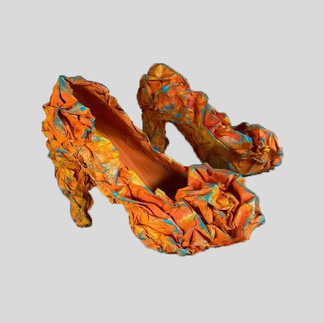



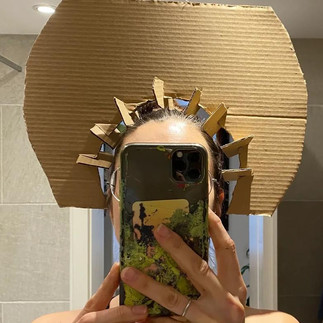

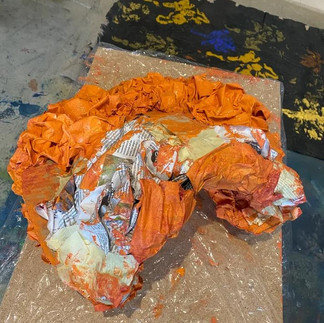
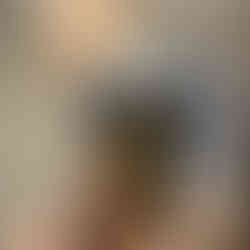



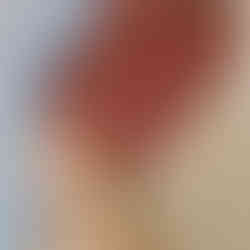









Comentários